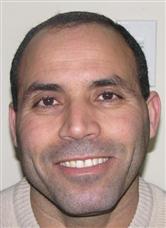Protesters Trick-or-Treat Across Canada as CSIS, Page 3
"Who is the Terrorist?" introduces us as well to the ghost of Izzy Asper and goes on to reveal an individual who has an Osama bin laden face on. The face flips up, underneath which we find George Bush, who is immediately shackled, has a paper bag thrown over his head, and is led with ball and chain attached up the roadway towards the main gate of CSIS.
Police are unprepared and immediately hustle into position, with media following behind.
"Hello CSIS, open up, we have a terrorist for you!" the circusmaster calls out, cracking her whip as the Raging Grannies launch a new rendition of an old Christian gospel number, "What a Friend We Have in CSIS" (full lyrics below).
CSIS does not seem interested in this terrorist (after all, he's a militant Christian extremist, and since CSIS has stated time and again it is interested only in militant Muslims, Bush doesn't make the grade). We then launch a community tour of the massive perimeter of the CSIS bunker, which is surrounded on almost all sides by field, forest and swamp.
The building is, at some points, high on a hill, and one needs to climb through flora and fauna to get to the top of an embankment to see it. At other points, one climbs to an embankment and looks down on the building from a high vantage point.
Our first stop is one such place where, as we come up the hill and look down through the fence at the receiving area, about 25 spies are out having a smoke break. The second they see us, led by Ed Babb of Burlington and his 12-foot high, 3-foot-wide Question Authority sign, they immediately drop their smokes and hightail it to the door, faster than a bunch of racing keystone kops in a silent movie. We have never witnessed such a fast exit, and it was comical and scary at the same time: what on earth could have prompted them to be afraid of us?
As CSIS employees peak out from the windows, they pull back from sight when we acknowledge them and wave. They can never be too careful -- they may be spotted by a Raging Granny. One woman holds a large sandwich board which references Canada's Secret Trial Five: "I am Mohammad Mahjoub, I am Mahmoud Jaballah, I am Hassan Almrei, I am Mohamed Harkat, I am Adil Charkaoui, I am a human being. I have a right to a fair trial."
As we continue the tour -- which could double as a massive bird watching expedition given the pastoral setting -- we are led by radical cheerleader Matt Corks of Kitchener, who stands atop a hill and gets some rousing chanting going. Two newspaper photographers from the Ottawa area are taking pictures, and one of them turns to the other and says, "I suppose we'll be getting a visit at the office from these guys for taking pictures of their building, eh?" The message is clear. CSIS does not like people in its vicinity, and no matter how friendly the visitor, one cannot help but think that our presence will result in some sort of payback later on.
Indeed, much of our campaign focuses on CSIS payback: how individuals who have refused to spy on their communities have been thrown behind bars on secret evidence, held without charge or bail. In other cases, Canadians have been kidnapped and sent abroad, where foreign intelligence agencies do their dirty work in torture chambers and Guantanamo-Bay style legal black holes.
Throughout the gathering, there is a sense that this is more than a demonstration. It is almost like a preliminary inquiry by the community, a step in the process of opening up an institution which has hidden behind closed doors for far too long. It sometimes feels like we're checking out the neighbourhood before deciding whether we'll move in.
While the scads of police and security forces indicate CSIS believes we pose a threat, the tone of the day is quiet, calm, at times hilarious, and determined. Here we are in a kind of terrorist meet-and-greet, for it is we -- people who oppose the kinds of economic policies ("globalization") that impoverish the majority of the world, that destroy the environment, that factory farm our food, that result in the use of state terror such as massive bombardment of poor countries -- whom CSIS considers a domestic terrorist threat. Just look at their public report to Parliament in June 2003, and there we are sandwiched between "Muslim extremists" and white supremacists.
By the time we get to the Blair Road entrance to CSIS, we again try and turn in terrorist Bush, who has been calling out, "We love democracy so much that we'll carpet-bomb anyone who doesn't allow us to impose it on them."
Police inform us warily that a red backpack has been left out in the wooded area behind CSIS, and ask if we can investigate. While this might seem like a complete abrogation of the police's responsibilities, we agree to look into it. After all, being good little anarchists who feel that the community can solve its own problems without toting guns and pepper spray, we are more than happy to save the day. Which we proceed to do, as a friend on a bicycle calls in to say he has arrived on the scene, where a number of cops are looking on but taking no action regarding the backpack. Our friend notes that he recognizes the backpack as something left inadvertently by a fellow demonstrator, and it is returned.
Edgecombe calls in to see how things are going. I try and explain where we are at the perimeter, but he says no need. CBC has been covering the demo live, and so he knows where to find us, thanks to the coverage.
We sing happy birthday to CSIS (they turn 20 next year) and hope that as they mature they will learn how to write an affidavit, how to tell the truth, and how not to discriminate based on faith and skin colour. We hope those will be some of their birthday wishes when they blow out their candles next year.
As we head toward the main entrance again after our long jaunt, some concerns arise. It is clear that in a regular protest, we all would have been cautioned by now not to be so close to the perimeter fence on "private property," but CSIS has conceded issues of property lines today. As long as we stay behind the fence, it seems, we will not be charged.
This leads to a discussion about whether we are being baited to breach the fence and enter a security zone, where normal criminal code and provincial offences might no longer apply, and where 72-hour detention without charge might kick into play if we are caught on the other side. It's a serious issue which we need to consider as we head back to the front gates.
We gather again at the Ogilvie entrance, which has been closed shut all morning. On a normal day, one can walk or drive right onto CSIS property. But this is no ordinary day, so access could only be allowed when the electronically operated fence slides in horizontal fashion from right to left.
At first sight, it appears the demonstrators have few options. If they want to gain access, they will have to climb the high fence. We have no ladders, and are unprepared for such a scenario. From the police point of view, their job is easy: as long as the fence is closed, we are kept out. If someone should climb the fence, they will set loose police dogs on us.
But anyone looking at this scene from an objective distance might stop to ask themselves: if CSIS is such a bunch of security geniuses, and their building is so damned secure, how is it that their sliding electric fence, now closed to prevent our access, is planted a good 18 inches off ground level?
A group of trick-or-treaters approaches the fence and places placards and security certificates on the chain links. Some signs read "Free the Secret Trial Five," "11 Kids, Four Women: Guilty by Association?" and "Abolish the Security Certificate," among others. On the other side, police stand their ground, not reacting.
We carefully change our position, and sit on the ground, placing our trick-or-treat bags under the fence, opening them up, and asking for the secret evidence. We try and speak with the security forces massed on the other side. We plead with them to think about the children, the wives, and loved ones, the community members, all whose lives are terrorized by CSIS. We talk about Nuremberg, about how we are in dangerous times which will lead us down the same road which led to concentration camps and massive human rights violations, a made-in-Canada Gulag. They stand without emotion, trying not to look in our eyes.
As we sit in front of the fence, we marvel at how easy it would be to slide underneath and get inside to continue our trick-or-treat expedition. And so what is the subject of whimsical thinking soon becomes a reality. Anet Henrikso of Montreal slips under the fence and gets up on to the shock and amazement of officers on the other side. Despite the intimidating barking of police dogs heard just beyond, she walks to the officers, demanding to see the secret evidence. She is followed quickly by Ed Babb of Burlington who, at 73, executes a slide onto CSIS sacred ground worthy of a major league ball player turning a double into a triple (see the CSIS version of Take Me out to the Ballgame, below). Babb's maneuver also allows some time for Matthew Behrens of Toronto to slip under as well, followed closely by Melanie, who lives in Ottawa.
As the police try and deal with us, a number suggest we get up and go outside the fence. Rather than drag us over and under, they make a brilliant gaffe, typical of those CSIS makes year in and year out. They start to open the sliding electric fence, potentially allowing access to a much larger group of people whose faces are pressed against it. The demonstrators are just as shocked at this boner as the media, but before they can recover and start entering, police rush past those who have already breached the fence, and the fence is just as quickly closed.
We sit awaiting our fate, and are eventually arrested and escorted past a van with barking police dogs, charged with trespassing, handcuffed behind our backs, and placed in a cramped police van where we sit for more than two hours, awaiting word on where we'll be taken. Anet is taken downtown, to be released later on a criminal charge of violating bail conditions from a prior demonstration. The rest of us are charged with trespassing.
In yet another case of mistaken identity, Melanie, who is transgendered, insists on being placed in a van with women, but police refuse her request, and place her with the men.
Despite busting me, placing me in cuffs behind my back, and herding me into a kennel-like, airless police van, my arresting officer has been reasonably friendly, but a tad nervous. As he holds my arm, I can feel him trembling. I tell him that I do not want him to feel personally threatened, that I am here committed to nonviolence, have no weapons, and that I would like to be escorted inside CSIS to meet spymaster Ward Elcock, to whom an open letter was sent more than a month ago informing him of our visit. I ask if he knows why we are here. He nods, seeming vaguely familiar with the crimes we are protesting.
But during processing, his tone suddenly changes for the more serious. He asks me if I have any outstanding conditions. I shake my head no. He asks why it is, then, that an RCMP search shows that following my "contact with police in Ottawa" in early August I had conditions placed on me. This is odd, for I was not in Ottawa in early August, but only on August 25, when the families of Canada's disappeared were all together in an attempt to visit prime minister Jean Chretien. (We had discussed the idea of going earlier in August, but abandoned those plans.)
August 25 was a simple, peaceful affair, but it appears that a plan for a pre-emptive August arrest might have been entered on the computer system, complete with possible release conditions designed to either prevent myself and other members of our delegation from attending the October 31 demonstration and/or from even entering Ottawa. The latter condition has been placed on numerous recent arrestees in the nation's capital.
Although such an arrest did not occur, it is possible the "expected" arrest and subsequent release conditions had not been removed from the system, and they were coming up now during the standard computer check for all arrestees.
The officer is confused, and says he will make inquiries. He returns later and when I ask him what he was talking about, he shrugs it off with an "It's all cleared up, nothing to worry about." One wonders...
As we wait in the cramped van, we listen to the odd report over the police radio. Many cops comment on Ed Babb's massive Question Authority sign, which is still being held high on the other side of the fence, and which seems to have gotten under the skin of many of the authorities on site!
After about an hour, the remainder of the demonstration comes to an end and folks board the bus back to the church, escorted by numerous police vehicles and motorcycle cops. We witness delivery trucks, garbage trucks, and other vehicles turned away. No one gets in to CSIS as long as we are in that van, and, as we later learn, as long as we remain in the city.
As we finally depart, we are pleased to see out the back of the van that someone with thick, permanent marker has written on the box operating the entrance gate: Free the Secret Trial Five: Abolish the Secret Trial Security Certificate! It will need a new paint job to get rid of that one.
As we make our way back downtown, we hear the police radio blaring out instructions: make sure these people are on their bus and out of town by 1:30 pm. Repeat, continue to monitor the church and ensure no one stays behind or returns to CSIS. Our van is escorted by a number of undercover police vehicles.
While one hates to see such a waste of public resources spent on us, we are pleased that, at least for today, these forces of the state focused on us are not able to maintain their incessant harassment of the targeted communities who were at the focus of the demo.
Now that we have been charged, we can proceed to plan a trial where we can subpoena Ward Elcock, and finally get that opportunity to ask how he thinks secret trials are compatible with demoracy and human rights.
As we clean up the church, a row of motorcycle cops sits across the street, along with police in unmarked vehicles, making sure we get out of town. As the bus heads to southern Ontario, a number of us remain to ensure that Anet is released from the downtown police station, where she is held till 3 pm on the criminal charge of breaching bail (she had been arrested while standing around with several hundred other people in the massive Montreal police sweep during the G-20 demonstrations in July).









